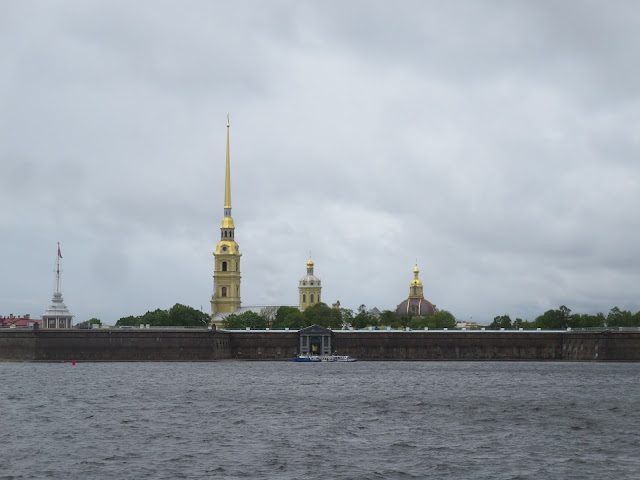Day 4- June 3- temp 38 and
cold Off to Peterhoff Palace and Park. - the Russian
Versailles. In the afternoon St.
Petersburg from the water.
A view taken from the internet because I couldn't get a picture to show the grandeur of the "summer place". 1700's
"Peter the Great first mentions the Peterhof site in his journal in 1705, during the Great Northern War, as a good place to construct a landing for use in travelling to and from the island fortress of Kronstadt. And in 1714, Peter began construction of the Monplaisir ("my pleasure") Palace based on his own sketches of the palace that he wanted close to the shoreline. This was Peter's Summer Palace that he would use on his way coming and going from Europe through the harbour at Kronstad."
 The fountains come on at 11:00 so they were turned on after this picture was taken. There are some 75 fountains in the front.
The fountains come on at 11:00 so they were turned on after this picture was taken. There are some 75 fountains in the front.The sea is in the direction behind me. I believe this is a guest house.
One of the many fountains to be seen.
My traveling buddies! a motley crew we are all bundled up!
They are on!
I found it fascinating to see the before after effects of the war so I put them in my blog. The building below is this photo.
Here is another example of the restoration that had to be done after the war. The building below is the now,
Another picture showing the work that was done,
There were no pictures allowed to be taken in the palace so these are just a few of the many postcards that I bought. ( it took all day to get these few transferred!)
The Chesma Hall is decorated with twelve large paintings of the Battle of Chesma, a stunning naval victory of the Russo-Turkish War, 1768-1774. These were painted between 1771 and 1773 by the German artist Jacob Philipp Hackert. His first renderings of the great battle scenes were criticised by witnesses as not showing realistically the effect of exploding ships — the flying timbers, great flames, smoke, and fireballs. Catherine II assisted the artist by exploding a frigate in the harbour of Livorno, Italy, for the benefit of Hackert, who had never seen a naval battle first-hand. Hackert also did not research the actual positions of the Russian and Turkish forces during the battle, so the scenes depicted are somewhat fanciful, but do effectively convey drama and destruction of naval warfare.
The Ball room
The Western Chinese Lobby
The Picture Room
I am going to do the afternoon session in a different blog as this already has several pictures.
ciao :)
















































